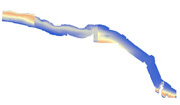| Description |
This part of DS 781 presents data for the map showing the predicted distribution of brittle stars in the Santa Barbara Channel, California, region. The raster data file is included in "BrittleStars_SantaBarbaraChannel.zip," which is accessible from https://pubs.usgs.gov/ds/781/SantaBarbaraChannel/data_catalog_SantaBarbaraChannel.html. Presence-absence data of benthic macro-invertebrates and associated habitat (that is, sediment type and depth) were collected using a towed camera sled in selected areas along the coast off southern California during a ground-truth observation cruise conducted by the U.S. Geological Survey and NOAA National Marine Fisheries Service for the California Seafloor Mapping Program. Benthic community structure was determined from 35 video towed-camera transects within California's State Waters 3-nautical-mile limit in the Santa Barbara Channel. These transects produced a total of 923 10-second observations from the Offshore of Refugio Beach map area (34.5 degrees N., 120.1 degrees W.) to the Hueneme Canyon and vicinity map area (34.1 degrees N., 119.2 degrees W.). Presence-absence data were collected for 29 benthic, structure-forming nonmobile taxa. Using this information, generalized linear models (GLMs) were developed to predict the probability of occurrence of five commonly observed taxa (cup corals, hydroids, short and tall sea pens, and brittle stars in the sediment) in five map areas within the Santa Barbara Channel (SBC). A sixth map area (Offshore of Carpinteria) was not modeled owing to insufficient data. The analysis demonstrates that the community structure for the five map areas can be divided into three statistically distinct groups: (1) the Hueneme Canyon and vicinity and the Offshore of Ventura map areas; (2) the Offshore of Santa Barbara and the Offshore of Coal Oil Point map areas; and (3) the Offshore of Refugio Beach map area. These three distinct groups are the main reason that the probability for each taxa can be so dramatically different within one predictive-distribution map area. The five most frequently observed benthic macro-invertebrate taxa were selected for these predictive-distribution grids. Presence-absence data for each selected invertebrate were fit to specific generalized linear models using geographic location, depth, and seafloor character as covariates. Data for the covariates were informed by the bathymetry, seafloor character, and other ground-truth data from the different map areas of the Santa Barbara Channel region that are part of the California State Waters Map Series DS 781. Observations based on depth were limited by the capability of the towed camera sled; as a result, no predictions were made below depths of 150 m (in other words, on the continental slope or in Hueneme Canyon). Cup corals and hydroids had high predicted probabilities of occurrence in areas of hard substrata, whereas short and tall sea pens were predicted to occur in parts of the SBC that had unconsolidated and mixed sediment. Our model predicted that brittle stars would occur throughout the entire SBC on various bottom types. [More]
|
